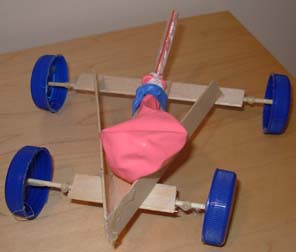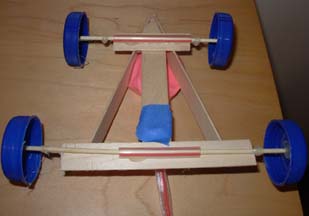Make a balloon-powered car
Make a balloon-powered car

These are fun little things - I remember getting one as a cereal box prize when I was a kid. You blow up a balloon attached to a car, set it down and let it race across the floor. And even using a store-bought one, you have an illustration of the principles of rocket engines and Newton's Third Law of Motion (the equal-and-opposite force law). That is, the balloon pushes the air back, and that pushes the car with equal force in the opposite direction. This is the same principle that makes real rocket engines work in space - the engine pushes out hot gasses from the combustion inside, and that pushes the rocket forward in space.
Designing your own balloon car puts you up against all sorts of fun mechanical challenges and is full of Big Learning opportunities related to mechanics. Here are two designs I looked at, which each use recycle-bin materials:
http://quest.nasa.gov/space/teachers/rockets/act2ws1.html
http://www.questacon.edu.au/html/squad_activities/balloon_powered_car.html
I really liked the first design, but you make the whole car from a styrofoam meat tray, which I didn't have. So I worked from the second design.
Parts of a Balloon Racer
No matter what design your child chooses, he or she will need the following parts:
A body - something to hold the balloon that will power the car. The first design uses styrofoam; the second uses cardboard.
Wheels - the first design uses circles cut from the meat tray. The second uses bottle tops. You can use any round object. I even made wheels from craft foam in one of my versions.
Axle - the straight stick that holds the wheels. The first design uses straight pins, and the second designs uses bamboo skewers.
Bearing - Something for the axle to turn inside. The first design uses the Styrofoam body itself. In the second, the bamboo axle is threaded through a drinking straw.
Engine - In this case, the balloon. Both designs use a balloon rubber-banded to a straw so you can easily blow it up once it's on the car.
Your child can find these same parts on a real car or a toy one, though sometimes they are hard to see.
What will you do?
So a Big Learning task for your child is: figure out what you have on hand that can serve for each of the parts above. Maybe you don't have a meat tray, but you have some poster board. With each choice of materials you make, your child will have to figure out what implications that choice has for the design. Help your child keep in mind what she's making - for example, an axle, by using the vocabulary words when you talk about it.
For example, here's what we did. We had the materials on hand for most of the second design, but I didn't like having to punch holes in the plastic drink caps - that's really hard without a drill, and I figured we'd poke a hole in our table or hands. It also calls for plasticine (modeling clay) which I didn't have.

So we hot-glued the bamboo skewer axle to the bottle caps, using big blobs of hot glue. That worked really well.
And I as long as I had my glue gun out, I decided to use my beloved jumbo craft sticks to make the body. To me, using cardboard for anything just makes it look junky.
So, here's how we made our car.
1. Cut the front and rear struts and hot-glue pieces of straw to them.
2. Hot glue one end of the axle to the center of a bottle top. Hold it for a minute while it sets.
3. Thread the axel through one of the straws. Hot glue on the other wheel.
4. Put blobs of hot glue on the axel near the straw but not touching it. That keeps the axel from sliding too far through the straw.
5. Repeat to install the other axle.
6. Build the top of the car. Connect the two struts with a craft stick. Cut two craft sticks for the sides and glue them as shown in the photo to form the sides of the car.
7. Fasten a balloon to a bendy-straw with a rubber band. Use masking tape to fasten the balloon and straw to the car.